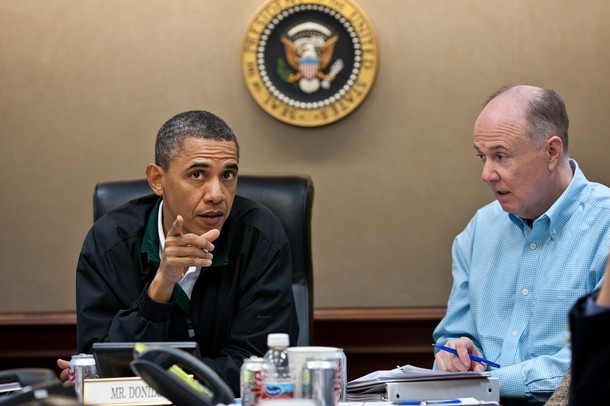
The November 8 International Atomic Energy Agency (IAEA) report casts further doubt on Iran’s continual claims that its nuclear program is intended solely for peaceful use. Rather than halting its weapons program in 2003, as was reported in a controversial 2007 U.S. National Intelligence Estimate, Iran has apparently continued to develop the various components necessary to produce a nuclear weapon, including neutron initiators, which trigger nuclear chain reactions, and complex explosives needed to build a warhead small enough to place atop a ballistic missile. Meanwhile, Tehran has openly worked to increase its stockpile of low-enriched uranium — especially uranium enriched to 20 percent — which could be further refined to weapons grade. If the IAEA’s suspicions are correct, Iran might have both the technology and material to build a nuclear bomb in a matter of months.
To date, the United States has relied on a combination of sticks and carrots to prevent Iran from going nuclear. It has tightened economic sanctions against the regime, isolated it diplomatically, and offered improved relations in return for Tehran abandoning its nuclear ambitions. The attractions of this approach are readily apparent. The main alternative, a military operation against Iran’s nuclear infrastructure, would likely be extremely costly and might not even succeed. Moreover, by slowing Iran’s progress toward a nuclear weapon, sanctions and isolation buy time for a "silver bullet," such as an internal political change that brings a more moderate Iranian leadership to power or a sabotage effort that derails the program for the foreseeable future. Unfortunately, no such solution has presented itself: The current Iranian regime has remained in control despite popular unrest and an ongoing dispute between the president and the supreme leader, and the new IAEA report suggests that efforts to disrupt Iran’s nuclear program have so far yielded naught. All the while, Iran is getting closer to crossing the nuclear threshold.
Even so, the U.S. government might persist with its existing approach if it believes that the consequences of a nuclear-armed Iran are manageable through a combination of containment and deterrence. In fact, the Obama administration has downplayed the findings of the new IAEA report, suggesting that a change in U.S. policy is unlikely. Yet this view underestimates the challenges that the United States would confront once Iran acquired nuclear weapons.
For example, the Obama administration should not discount the possibility of an Israeli-Iranian nuclear conflict. From the very start, the nuclear balance between these two antagonists would be unstable. Because of the significant disparity in the sizes of their respective arsenals (Iran would have a handful of warheads compared to Israel’s estimated 100-200), both sides would have huge incentives to strike first in the event of a crisis. Israel would likely believe that it had only a short period during which it could launch a nuclear attack that would wipe out most, if not all, of Iran’s weapons and much of its nuclear infrastructure without Tehran being able to retaliate. For its part, Iran might decide to use its arsenal before Israel could destroy it with a preemptive attack. The absence of early warning systems on both sides and the extremely short flight time for ballistic missiles heading from one country to the other would only heighten the danger. Decision-makers would be under tremendous pressure to act quickly.
Beyond regional nuclear war, Tehran’s acquisition of these weapons could be a catalyst for additional proliferation throughout the Middle East and beyond. Few observers have failed to note that the United States has treated nuclear-armed rogues, such as North Korea, very differently from non-nuclear ones, such as Iraq and Libya. If Iran became a nuclear power and the United States reacted with a policy of containment, nuclear weapons would only be more appealing as the ultimate deterrent to outside intervention.
Meanwhile, Iran’s rivals for regional dominance, such as Turkey, Egypt, and Saudi Arabia, might seek their own nuclear devices to counterbalance Tehran. The road to acquiring nuclear weapons is generally a long and difficult one, but these nations might have shortcuts. Riyadh, for example, could exploit its close ties to Islamabad — which has a history of illicit proliferation and a rapidly expanding nuclear arsenal — to become a nuclear power almost overnight.
During the Cold War, of course, the United States managed to prevent nuclear use and discourage proliferation by containing the Soviet Union and providing security commitments to U.S. allies. According to the conventional wisdom, a similar approach would work in the Middle East today. Yet there are a number of important differences between the two cases, the biggest being that the United States had formal security commitments with partners across Europe and Asia and deployed hundreds of thousands of troops to their territories.
The closer Iran gets to acquiring nuclear weapons, the fewer options will be available to stop its progress. At the same time, Iran’s incentives to back down will only decrease as it approaches the nuclear threshold. Given these trends, the United States faces the difficult decision of using military force soon to prevent Iran from going nuclear, or living with a nuclear Iran and the regional fallout.
Eric S. Edelman is an Atlantic Council Board director, and distinguished fellow at the Center for Strategic and Budgetary Assessments; he was U.S. undersecretary of defense for policy in 2005-9. Andrew F. Krepinevich Jr. is president of the Center for Strategic and Budgetary Assessments. Evan Braden Montgomery is a research fellow at the Center for Strategic and Budgetary Assessments. This piece originally appeared in Foreign Affairs.
Image: getty%206%206%2011%20Barack%20Obama%20Tom%20Donilon.jpg
